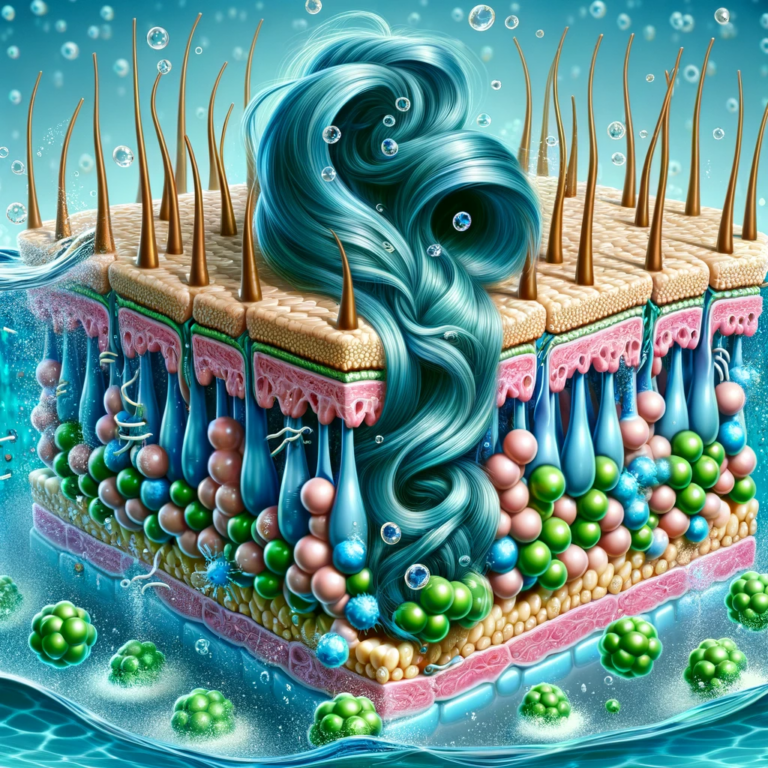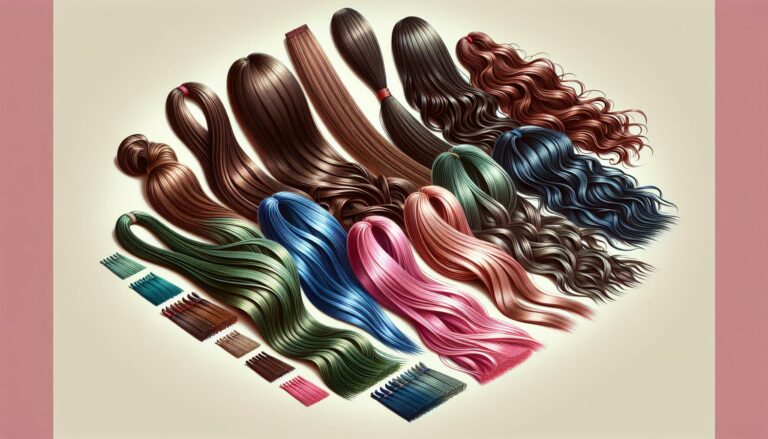Headache After Dyeing Hair
Ever wondered why you get a headache after dyeing your hair?
It’s a concern shared by many. These headaches can arise from various factors associated with the hair dyeing process.
Well, we’ll be going over:
- What ingredients in hair dye could potentially trigger a headache?
- How can the physical process of dyeing hair at a salon contribute to the onset of a headache?
- What steps can you take to alleviate or prevent headaches associated with hair dyeing?
Let’s dive in.

Key Takeaways
- Hair dye contains chemicals that can cause an allergic reaction or irritation to the scalp, leading to a headache.
- Symptoms of a hair dye headache include pain, pressure, and a throbbing sensation in the head.
- Remedies for a hair dye headache include over-the-counter pain relievers, cold compresses, and avoiding hair dye altogether if you are prone to headaches.
Understanding Hair Dye Ingredients
When it comes to dyeing your hair, it is important to understand the ingredients in the hair dye you are using. Hair dyes contain many chemicals that can cause skin irritation, allergic reactions, and even headaches.
Common Chemicals in Hair Dyes
Hair dyes contain a variety of chemicals, but some of the most common ones include ammonia, hydrogen peroxide, and paraphenylenediamine (PPD). Ammonia is used to open up the hair cuticle so that the dye can penetrate the hair shaft.
Hydrogen peroxide is used to bleach the hair and make it lighter. PPD is a dye that is used to give hair its color.
Potential Allergens and Irritants
PPD is one of the most common allergens found in hair dyes and can cause severe allergic reactions in some people. Other potential allergens and irritants found in hair dyes include resorcinol, toluene-2,5-diamine, and fragrance. These ingredients can cause skin irritation, redness, and itching.
It is important to note that even if you have used a particular hair dye before without any issues, you can still develop an allergic reaction to it in the future. It is always a good idea to do a patch test before using any new hair dye.
In addition to understanding the ingredients in your hair dye, it is important to follow the instructions carefully and avoid leaving the dye on your hair for longer than recommended. This can cause scalp irritation and even lead to headaches.
Overall, understanding the ingredients in your hair dye and taking the necessary precautions can help you avoid potential allergic reactions, skin irritation, and headaches.
Symptoms of Hair Dye Reactions
Hair dyeing is a popular cosmetic practice that can help you achieve a new look or cover up gray hair. However, using hair dye can cause adverse reactions that range from mild to severe. Symptoms of hair dye reactions can vary depending on the individual and the type of dye used.
Skin and Scalp Irritation
One of the most common symptoms of hair dye reactions is skin and scalp irritation. This can include itching, burning, redness, and swelling. These symptoms can occur immediately after dyeing your hair or several days later. In some cases, the irritation can be severe enough to cause blisters or sores on the scalp.
Respiratory Issues and Headaches
In addition to skin and scalp irritation, some people may experience respiratory issues and headaches after dyeing their hair. This can include coughing, wheezing, and difficulty breathing. Headaches and migraines are also common symptoms of hair dye reactions. These symptoms can be caused by the strong odor of the dye or the chemicals used in the dyeing process.
If you experience any of these symptoms after dyeing your hair, it is important to seek medical attention. In some cases, hair dye reactions can be severe and require immediate treatment. Nausea and skin irritation are other possible symptoms of hair dye reactions that should not be ignored.
To minimize the risk of hair dye reactions, it is important to follow the instructions on the dye package carefully and perform a patch test before using the dye. If you have a history of allergies or sensitive skin, it is recommended to consult with a dermatologist before dyeing your hair.
Preventing Negative Reactions to Hair Dye
If you are experiencing headaches after dyeing your hair, it is important to take precautions to prevent negative reactions to hair dye. Here are some prevention tips to help you avoid allergic reactions:
Conducting a Patch Test
Before you dye your hair, it is important to conduct a patch test. This will help you determine if you are allergic to any of the ingredients in the hair dye. To conduct a patch test, apply a small amount of hair dye to a small area of your skin, such as behind your ear. Wait for 48 hours and monitor the area for any signs of an allergic reaction, such as redness, itching, or swelling. If you experience any of these symptoms, do not use the hair dye.
Choosing the Right Products
When choosing hair products, it is important to read the labels carefully. Look for products that are labeled as hypoallergenic or designed for sensitive skin.
Avoid products that contain harsh chemicals, such as ammonia and peroxide, as these can cause irritation and allergic reactions. Additionally, consider using natural hair dyes, such as henna, which are less likely to cause negative reactions.
Taking these precautions can help you avoid allergic reactions and headaches after dyeing your hair. If you do experience an allergic reaction, seek medical attention immediately. You can also consult with an allergy clinic to determine if you have any underlying allergies that may be contributing to your symptoms.
Immediate Actions and Remedies
If you’re experiencing a headache after dyeing your hair, you may be wondering what immediate actions you can take to alleviate the pain. Here are some tips to help you feel better:
When to Consult a Healthcare Professional
If your headache is severe or persistent, or if you experience any other symptoms such as dizziness, nausea, or difficulty breathing, you should seek medical attention immediately. These symptoms may be a sign of an allergic reaction to the hair dye, which can be life-threatening if left untreated.
If you have a history of migraines or other types of headaches, you may be more susceptible to developing a headache after dyeing your hair. In this case, it’s important to consult with a healthcare professional to determine the best course of treatment.
Home Remedies and Over-the-Counter Solutions
There are several home remedies and over-the-counter solutions that may help alleviate your headache after dyeing your hair. Here are a few options:
- Take an over-the-counter pain reliever such as ibuprofen or acetaminophen.
- Apply a cold compress to your forehead or the back of your neck.
- Take a warm bath or shower to help relax your muscles.
- Practice relaxation techniques such as deep breathing or meditation.
- Use a steroid cream or other emollients to soothe any skin irritation caused by the hair dye.
It’s important to note that while these remedies may provide temporary relief, they are not a substitute for professional medical advice. If your headache persists or becomes more severe, be sure to consult with a healthcare professional.
Long-Term Hair Health and Maintenance
When it comes to maintaining healthy hair, it’s important to consider the long-term effects of hair dyeing. While hair dyeing can be a fun way to change up your look, it can also cause damage to your hair if not done properly.
In this section, we’ll discuss how to care for color-treated hair and alternative options to traditional hair dyes.
Caring for Color-Treated Hair
If you’ve recently dyed your hair or have been dyeing it for a while, it’s important to take extra care of your hair to maintain its health. Here are some tips to help keep your color-treated hair looking great:
- Use a sulfate-free shampoo and conditioner specifically designed for color-treated hair. Sulfates can strip the hair of its natural oils, causing it to become dry and brittle.
- Avoid washing your hair too frequently. Washing your hair too often can cause the color to fade more quickly.
- Use a deep conditioning treatment once a week to help repair any damage caused by the dyeing process.
- Protect your hair from the sun by wearing a hat or using a UV-protectant spray.
Alternatives to Traditional Hair Dyes
If you’re concerned about the potential long-term effects of traditional hair dyes, there are alternative options available. Here are a few to consider:
- Henna: Henna is a natural plant-based dye that can be used to color hair. It’s a great option for those who want to avoid harsh chemicals.
- Semi-permanent hair dye: Semi-permanent hair dye is a gentler option than permanent hair dye. It typically lasts for 6-8 weeks and gradually fades over time.
- Permanent hair dye: If you prefer a longer-lasting option, permanent hair dye is still a viable choice. Just be sure to follow the instructions carefully and take extra care of your hair to minimize damage.
By following these tips and considering alternative options, you can maintain healthy, beautiful hair for the long-term.
Frequently Asked Questions
What are the potential causes of headaches after hair coloring treatments?
Headaches after hair coloring treatments can be caused by a variety of factors. One possible cause is an allergic reaction to the hair dye, which can lead to inflammation and pain. Another possible cause is the strong chemical odor emitted by hair dye, which can trigger headaches in some people.
Additionally, the physical process of sitting still for an extended period of time while getting your hair dyed can cause tension headaches.
Is it safe to apply hair dye if I’m already experiencing a headache?
It is not recommended to apply hair dye if you are already experiencing a headache. The chemicals in hair dye can exacerbate your headache symptoms and make them worse. It is best to wait until your headache has subsided before applying hair dye.
How can chemical fumes from hair dye contribute to dizziness or headaches?
The strong chemical fumes emitted by hair dye can contribute to dizziness or headaches by irritating the respiratory system and causing inflammation. Additionally, the fumes can cause a decrease in oxygen levels, which can lead to feelings of dizziness or lightheadedness.
What symptoms indicate possible hair dye poisoning through the scalp?
Hair dye poisoning through the scalp can cause a range of symptoms, including headache, dizziness, nausea, vomiting, and difficulty breathing. If you experience any of these symptoms after applying hair dye, seek medical attention immediately.
Are there any long-term effects of hair dye on the brain that could lead to headaches?
There is currently no evidence to suggest that hair dye has any long-term effects on the brain that could lead to headaches. However, it is important to note that some hair dyes contain potentially harmful chemicals, so it is always best to use caution when applying hair dye.
Can the physical process of hair dyeing at a salon trigger headaches?
The physical process of hair dyeing at a salon can trigger headaches in some people. Sitting still for an extended period of time, combined with the strong chemical odor emitted by hair dye, can cause tension headaches. Additionally, the stress of the salon environment can contribute to headaches.






